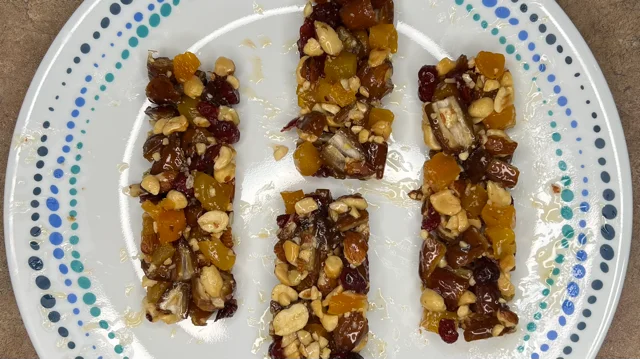- Home
- How to Dehydrate Fruit: Easy Tips for Perfect Results
How to Dehydrate Fruit: Easy Methods for Sweet, Long-Lasting Snacks

Susan Gast, Author
Blogger at Easy Food Dehydrating | A New Sober You | Bored Boomers | Beesville Books
Looking to dehydrate fruit properly using a dehydrator or other methods so you can enjoy its naturally sweet, concentrated flavors all year long?

Each fruit guide (linked below in red bars) walks you through simple step-by-step instructions—from choosing the best fruit to dehydrating it for optimal texture and taste. You’ll learn how to dry fruit using a dehydrator, an oven, or even the sun, creating delicious, preserved fruit snacks you can enjoy anytime.
Whether you prefer classic fruits like apples and berries or tropical varieties like mango and pineapple, I’ve got you covered. You’ll also find a special section on making chewy fruit leathers!
Stick with me and master the basics of fruit dehydration. Use your dried fruit in trail mixes, baked goods, and more!
Table of Contents
- Click to Learn About Specific Fruits
- Choose the Best Fruits for Dehydrating
- Frequently Asked Questions
- Why Dehydrate Fruit at Home? (Top Benefits)
- 3 Best Ways to Dehydrate Fruit (Oven, Dehydrator & Sun)
- How to Tell When Dehydrated Fruit is Done
- How to Store Dehydrated Fruit for Long-Term Freshness
- Can You Dehydrate Frozen Fruit? (Yes, Here’s How)
- Can Pets Eat Dehydrated Fruit? (Safe & Unsafe Choices)
- Grab 5 Dried Food Recipes You'll Actually Love
- Recent Articles
Click to Learn About Specific Fruits
Click images below to learn how to dehydrate these fruits:
Choose the Best Fruits for Dehydrating
Drying fruit is best done when your favorite fruits are in peak season. You’ll not only get better flavor but also save money, as fruits are most affordable when they’re abundant in grocery stores and at local markets.
💡 Pro Tip: Here’s a handy guide that shows you how much fresh fruit to buy to fill a 4-tray dehydrator efficiently!
Frequently Asked Questions
Is dehydrated fruit healthy?
Is dehydrated fruit healthy?
Absolutely! Dehydrated fruits are packed with vitamins, minerals, and fiber, making them an excellent snack. They provide slow-releasing energy, preventing blood sugar spikes and crashes.
Read more about the Pros and Cons of Dried Fruit here.
How do you make fruit leathers?
How do you make fruit leathers?
Fruit leathers (aka fruit roll-ups) are easy and delicious to make! I share my best technique for spreading purée evenly on trays for perfect drying results. Read the full guide here.
What’s the best temperature to dehydrate fruit?
What’s the best temperature to dehydrate fruit?
Most fruits dehydrate best between 125°F and 135°F. Check each fruit’s specific guide for exact temperatures and times.
Why Dehydrate Fruit at Home? (Top Benefits)
✅ Healthy, on-the-go snack
✅ Retains more nutrients than canning or freezing
✅ No added sugars or preservatives
3 Best Ways to Dehydrate Fruit (Oven, Dehydrator & Sun)
You can dehydrate fruit using an
- An Oven – Slower but widely accessible
- A Dehydrator – Faster, more efficient results
- The Sun – Eco-friendly, but takes longer
Oven Drying: A Simple, No-Equipment Method
- Preheat oven to 140-160°F
- Wash and slice fruit into uniform pieces
- Line a baking sheet with parchment paper or use a silicone mat
- Arrange fruit in a single layer, ensuring pieces don’t touch
- Bake for 6-8 hours, checking periodically
- Cool completely before storing in airtight containers
💡 Tip: Use our Fahrenheit to Celsius converter here on our site!
Using a Dehydrator for Perfectly Dried Fruit

- Wash and slice fruit evenly
- Arrange slices in a single layer on trays
- Set dehydrator to 135°F (or recommended temp per fruit)
- Dry for 6-8 hours (larger fruits like grapes may take longer)
- Cool & store in airtight containers
💡 Pro Tip: Check individual fruit pages for specific drying times and temperatures.
Sun-Drying Fruit: A Natural, No-Electricity Option
- Place fruit slices on a parchment-lined baking sheet
- Set in a sunny, well-ventilated area
- Cover loosely with mesh to prevent bugs
- Allow 2-4 days to fully dehydrate, flipping occasionally
- Store properly once dried
🚨 Weather matters! Ensure warm, dry conditions for best results.
How to Tell When Dehydrated Fruit is Done
Dried fruit should feel leathery yet pliable. If pieces stick together, allow them to sit in a Ziploc bag overnight for moisture distribution (conditioning) before vacuum sealing.
How to Store Dehydrated Fruit for Long-Term Freshness
✔ Airtight containers at room temp – lasts 6 months
✔ Refrigerator – lasts 1 year
✔ Freezer – lasts up to 2 years
💡 Best storage option? Use Mason jars for easy visibility!
Can You Dehydrate Frozen Fruit? (Yes, Here’s How)
Yes! Simply thaw frozen fruit in a sieve over a bowl (or the sink) to remove excess moisture before slicing it. Find specific details on each fruit’s individual page where applicable.
Can Pets Eat Dehydrated Fruit? (Safe & Unsafe Choices)

Yes! Dehydrated fruits & veggies make healthy treats for pets. Avoid added sugars and check safe options for dogs.
Check out my pumpkin treats for dogs for a nutritious, pet-friendly snack!
Grab 5 Dried Food Recipes You'll Actually Love
Don't forget to grab a copy of our all new
5 Dried Food Recipes (That Actually Taste Great)
They're my all-time favorite easy dried food meals!
Get it here right now.
For Free!
Before You Go...
If you like the content, please give me some love by clicking on the 🩷 in the lower right-hand corner (on just about all my pages). This signals to me that you find it enjoyable and useful.
And don’t forget to grab your FREE 5 Dried Food Recipes via the opt-in form — they're waiting for you! Thank you so much! (Get it here).




































